- Home
- Tori Harris
TFS Guardian: The Terran Fleet Command Saga – Book 5
TFS Guardian: The Terran Fleet Command Saga – Book 5 Read online
TFS GUARDIAN
The Terran Fleet Command Saga - Book 5
*****
Tori L. Harris
ISBN: 978-0-9985338-0-3
TFS GUARDIAN
THE TERRAN FLEET COMMAND SAGA - BOOK 5
VERSION 1.0
Copyright © 2018 by Tori L. Harris
All rights reserved. This eBook is licensed for the personal enjoyment of the original purchaser only. Thank you for respecting the hard work of this author. No part of this book may be reproduced or transmitted in any form or by any means, electronic or mechanical, including photocopying, recording, or by any information storage and retrieval system without the written permission of the author, except where permitted by law.
This is a work of fiction. The characters and events portrayed in this book are products of the author’s imagination or are used fictitiously. Any similarities to real persons, events, places, or organizations are purely coincidental and not intended by the author. Any references to actual places, people, brands, or other works of fiction are also fictitious.
Written and Published by Tori L. Harris
AuthorToriHarris.com
Edited by Monique Happy
www.moniquehappy.com
Cover Design by Ivo Brankovikj
https://www.artstation.com/artist/ivobrankovikj
Table of Contents
Prologue
Chapter 1
Chapter 2
Chapter 3
Chapter 4
Chapter 5
Chapter 6
Chapter 7
Chapter 8
Chapter 9
Chapter 10
Chapter 11
Chapter 12
Chapter 13
Chapter 14
Chapter 15
Chapter 16
Chapter 17
Chapter 18
Chapter 19
Chapter 20
Chapter 21
Chapter 22
Epilogue
Those who would give up essential Liberty, to purchase a little temporary Safety, deserve neither Liberty nor Safety.
Benjamin Franklin
Prologue
Pelara, The University of Taphis
(Two weeks ago - 3.87x103 light years from Earth)
Castigan Creel liked to think of himself as something of an alchemist. During his youth, he had eagerly consumed the stories of ancient philosophers on his world and others — fascinated by their belief that the elements, and even the fundamental forces of nature, could be harnessed for a variety of useful purposes. With age and experience, Creel had come to realize that much of what the alchemists believed had actually been correct. Unfortunately, they had been so far ahead of their time that they had often been inclined to conflate basic scientific concepts with various forms of mysticism — a convenient stopgap when the current state of knowledge simply wasn’t up to the tasks they were attempting.
This tendency towards the supernatural, in addition to getting a great many brilliant men and women burned at the stake, had created a common misconception that the alchemists’ entire body of work had been nothing more than an odd amalgamation of pseudoscience and the occult. In reality, however, they had been heralds of countless wonders to come — their experiments providing the methods, the terminology, and the scientific underpinnings that would eventually lead their once-primitive worlds to the stars.
Beyond their often-esoteric experiments, what resonated with Creel (technically Doctor Creel, but on Pelara, the use of such titles had all but disappeared) was the fact that the alchemists had been forced to do much of their work behind a veil of secrecy. From a practical perspective, keeping their work concealed was often nothing more than a means of safeguarding their most dangerous knowledge. In many cases, however, it wasn’t the knowledge of their most highly coveted methods that was so dangerous — transmuting lead into gold among them — but rather the revelation that the skills for which they were so handsomely paid simply didn’t work.
Ironically, Castigan Creel had almost exactly the opposite problem. His methods did work. And although he had never attempted to create the so-called “noble metals” from other, less valuable ones, what he could produce, seemingly from the ether itself, was the most valuable substance ever conceived. Unfortunately for Doctor Creel and the other modern practitioners of science on his world, doing so had been deemed to pose an unnecessary level of risk and, as such, was strictly forbidden.
Staring at the small screen displaying the interior of the reaction chamber, Creel noted the subtle changes in hue indicating conditions had reached their optimum state. Nodding confidently to himself, he pushed the transmit button on the ancient, console-mounted microphone to the right of his keyboard. “Control is go for initiate. Pre-ignition check, please.”
“Accelerator is go.”
“Laser is go.”
“Confinement is go.”
Hearing the disembodied voices of three of his former post-doctoral students (he still thought of them as his students, although he was well aware that all three were every bit as capable as he) caused Creel to pause and stare at the control panel for a moment. As their former professor, he was well aware they still deferred to him in many ways. Not for the first time, he wondered if what he was doing — what he had convinced his colleagues to do — could ever be justified from an ethical standpoint. Sure, they had taken precautions. And, thus far at least, their precautions had worked, allowing them to do what they were about to do on a great many occasions before tonight without detection. Nevertheless, each time they did so, he knew, the probability they would be detected by the Alliance AI — or, perhaps more likely, discovered and turned in to the Department of Compliance and Safety (DoCaS) by some “concerned citizen,” — increased significantly.
While the university’s particle physics research center routinely conducted high-energy research, all of it required an extensive approval process to ensure no laws governing the employment of “spacecraft or weapons-related” sciences were violated. Unfortunately, the work in which Creel’s small team had been engaging after-hours involved precisely the kinds of science those laws were intended to deter. For Creel, it wasn’t the act of breaking the absurd, draconian laws that bothered him. Instead, it was the fact that getting caught in the act of breaking them could potentially put the lives of everyone involved at risk. If they didn’t manage to conclude their work here soon, the law of averages would surely catch up with them. It simply wasn’t possible to release the levels of energy required, let alone produce the desired chain-reactions within the facility’s accelerator, without eventually attracting unwanted attention. At some point, they would get caught, and the consequences would be severe.
Creel took in a deep breath, shaking his head resignedly as he raised the red plastic guard in the center of the control panel. Just one more time, he promised himself as he flipped the toggle switch to initiate the reaction sequence. Inside the accelerator, a bank of ultra-high-powered laser emitters fired in unison — not at a specific target, but through a virtual, field-induced reaction chamber maintaining a near-perfect vacuum.
In spite of the misleading name, “space” is by no means empty. Instead, a hidden, cosmic soup of matter and antimatter particles continually hold one another in a fragile balance. Within the accelerator, as the beam emitters released their massive quantities of energy inside a tiny reaction volume, that fragile balance could no longer be maintained. As a result, a small rift in the fabric of space itself began to form. Fundamental particles — primarily electrons and positrons — spilled from the rift like Styrofoam pellets
pouring from an overstuffed beanbag chair sliced open with a sharp knife. Shortly thereafter, the atomic-level annihilations began.
As matter rapidly destroyed antimatter just outside the rift, gamma radiation catalyzed a chain reaction with a seemingly impossible result: the “creation” of additional matter/antimatter pairs that did not previously exist in normal space. Much like the naturally occurring reactions that occurred near the most powerful neutron stars, both matter and energy had been produced, seemingly where nothing at all had existed just moments before.
Sensing that conditions were now optimized within the chamber, Creel’s software triggered a subtle shift in frequency for the powerful beam emitters sustaining the reaction, altering its balance to an infinitesimal degree, but producing immediate and dramatic results. With a burst of bright light in the visible spectrum, the rift began releasing significantly more positrons, just as a stream of low-energy antiprotons was introduced into the chamber. As a result, large numbers of antihydrogen atoms began to form immediately below the rift.
In order to capture the priceless antimatter (while preventing a spectacular series of explosions), powerful magnetic fields coaxed the atoms along a predefined path leading eventually to the safety of a small, cryo-containment canister. By the end of tonight’s session, the team would produce nearly four hundred grams of antihydrogen. It wasn’t industrial-scale production by any means — even compared to the Wek operation at the Herrera Mining facility — but it did, nonetheless, represent the largest quantity produced on Pelara in more than a century. The ancient alchemists, Creel believed, would be justifiably proud.
That should do it … a grand total of eight kilograms, he thought. More than enough to bring her reactors online. Once that happens, she’ll be self-sustaining and generate enough additional power to —
“Attention on the net. Laser is scimitar, scimitar, scimitar,” Creel heard over the console speaker. At the outset of this project several months before, his former students had come up with several code words they would use over the facility’s closed-circuit intercom in the event of a problem. At the time, he had joked about the fact that “scimitar” sounded particularly ominous, but should at least help everyone to remember what it meant — their operation had been compromised.
Creel jabbed at the large, emergency stop button on the console, cutting power to the beam emitters and immediately terminating the reaction inside the chamber. At the same instant, an automated cleanup cycle was initiated that would allow the cryo-containment canister to be safely removed in just under three minutes. Glancing at his tablet, he noted the estimated antihydrogen total stood at just under three hundred grams. Not as much as expected, certainly, but it would most likely be enough. It would have to be enough.
Chiding himself that his first thought had been for the material results of his team’s work rather than for the individuals who had made that work possible, Creel picked up his tablet and clicked on the video feed covering the facility’s main entrance. He was fairly certain the voice he had heard over the intercom had belonged to Arcellia, but the members of his team often rotated responsibilities, and the fidelity of the small, ancient speaker made it difficult to know for sure. She didn’t sound particularly frightened, did she? he thought, realizing that his heart was racing and that he needed to calm himself down. No, she’s probably fine. It’s not like we didn’t plan for this. She knew exactly where to go and what to do. She’s long gone by now.
A light-enhanced black and white video feed filled his tablet’s screen, and he spent a few moments panning the camera back and forth, looking for anything unusual. Seeing no movement, no change in lighting, and no signs of forced entry, Creel breathed deeply and felt himself begin to relax a bit. The laser control station was located closest to the facility entrance, so it made sense that whoever was stationed there would be the first one to notice any unexpected visitors. At the moment, however, it looked like a false alarm. Arcellia, he knew, had been pounding down coffee all evening, so maybe she had gotten herself a little worked up. Even if it had been the authorities, anyone sitting at that control panel had numerous avenues of escape that outsiders wouldn’t expect, every one of which the team had practiced over and over until there should have been little chance of someone catching them by surprise.
It was at that moment that Creel heard the unmistakable sound of energy weapons fire from some distant location within the facility that was clearly nowhere near the main entrance. He had always hated that sound. It was as if the air itself were being ripped apart like a giant piece of cloth as superheated channels of ionized air were pushed explosively aside by the pulsed particle beam traveling at nearly the speed of light.
My God. Surely the police or DoCaS troops wouldn’t just open fire on sight, would they? he thought. No, probably not. But Wardens might, he corrected himself a moment later as a chill ran down the length of his spine.
Pelara and the core members of its powerful alliance had seen centuries of relative peace and prosperity as a result of the cultivation program. And with much of this success attributed to the widespread deployment of Guardian spacecraft, the creation of armies composed of fully autonomous, AI-controlled ground troops had been seen as a logical next step. At the time, most Pelarans agreed that truly civilized societies should never be required to put their citizens in harm’s way — not after technology had reached the point where such risks could be borne by machines. Few, if any, ever expected that these same machines might one day be deployed on their own homeworld to enforce the will of an occupying power over the Pelaran people.
Now feeling a desperate need to confirm who or what he was up against before attempting to make his own escape, Creel checked the timer on the reaction chamber cleanup cycle — still just over one minute remaining. With visibly shaking hands and a steady stream of sweat now trickling down the small of his back, he clicked back over to the security camera app and began the process of paging through every video feed in the building. Seeing nothing out of place other than the absence of his three colleagues, he switched back to a view of the accelerator/decelerator console.
Most of the equipment comprising the university’s particle accelerator complex was located underground along a twenty-five-kilometer-long, circular tunnel, but the main control room was at the far end of the building just one floor down from where Creel was sitting. Believing this to be roughly the location where the weapons discharge had taken place, he slowly panned the camera around the room, paying particular attention to the operator’s station and the room’s most likely exit.
Just as he was about to give up on the prospect of seeing anything on the video feed, Creel thought he detected an odd motion blur near the right side of the screen — a shadow cast by something just off camera perhaps. Hoping it would repeat, he stopped and waited, staring intently at the now-static image. Although he detected no additional movement, he did notice a dark, reflective substance in an irregularly shaped pool on the floor that he had somehow missed on first inspection. As Human minds are wont to do, Creel’s temporarily refused to accept the obvious explanation for what he was seeing. Instead, he continued to stare at the grisly scene as if trying to solve a particularly interesting puzzle. Only after several seconds had ticked by did his curiosity begin to be replaced by equal parts acceptance and horror. It was at that moment that he saw the top of what could only be an armored helmet of sorts pass across the bottom of the screen. Shortly thereafter, the video feed from the room went dark. A Warden, he thought. That had to be a Warden.
Not seen on Pelara in decades, WCS units (for Warden Combat System) had been instrumental in bringing the planet “under control” after the laws prohibiting weapons and spacecraft development, among many others, had been enacted. Ultra-intelligent, brutally effective machines, their initial designs had been based on the powered combat armor once used by Pelaran troops. As a result, they still retained a somewhat humanoid appearance. Given that most of their mission profiles required them
to operate effectively within structures and ships designed for less than two-meter-tall biological entities, most physical aspects of their design had changed little over the years. Fortunately, this size limitation also placed some practical limitations on the Wardens’ physical capabilities. Nevertheless, their speed and power still far exceeded all but the most advanced armored combat suits worn by biological troops. This distinction mattered little on Pelara, of course, where all such equipment had been confiscated long ago, even among law enforcement agencies. At the moment, in fact, there were few if any weapons on Pelara capable of even slowing a WCS unit down, let alone destroying one outright.
Doctor Creel stared transfixed at the blank screen, which now contained nothing more than a small text block indicating that it should have been displaying the accelerator/decelerator console feed. How much time do I have? A minute? Maybe less? he wondered, stunned into inaction by what he had just seen. At that moment, a faint chirping sound accompanied by a flashing green indicator on the Control console snapped his mind back to the present. Realizing he might still have a chance if he moved quickly, Creel jabbed at the canister release button, grabbed up his tote bag, and stepped over to a pedestal near the back of the room. There, a heavy metallic drawer looking much like those used in bank teller windows made a series of thuds and clicking sounds before opening to reveal a small, rectangular device with a built-in status display. Pausing just long enough to confirm the cryo-containment canister was functioning normally, Creel gingerly placed the device — including its cargo of two hundred ninety-eight grams of antihydrogen — into his bag.
His work now finished, Creel stepped quickly inside an adjacent equipment closet and closed the door behind him. Pushing aside a series of plastic strip doors used to contain refrigerated air around computer equipment, he uncovered a small, wall-mounted control panel as well as another heavy, steel door near the back of the closet. As he had practiced many times before, Creel flipped the three toggle switches on the panel in rapid succession, then grabbed the mass of keys hanging from the retractable chain on his belt. Fumbling for the right one, he noticed for the first time how badly his hands were shaking. At least one — most likely all three — of his former students were dead, and the realization that this was due to a situation entirely of his making threatened to unravel the very fabric of his sanity. It was only after what seemed like several minutes of agonizing effort that he finally managed to locate the key that unlocked the previously hidden door.

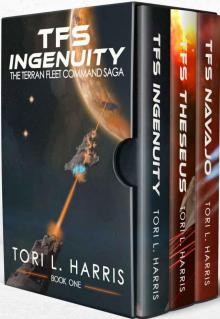 The Terran Fleet Command Saga BoxSet
The Terran Fleet Command Saga BoxSet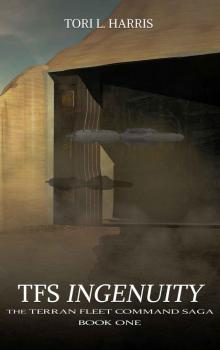 TFS Ingenuity: The Terran Fleet Command Saga – Book 1
TFS Ingenuity: The Terran Fleet Command Saga – Book 1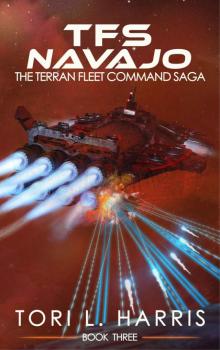 TFS Navajo: The Terran Fleet Command Saga – Book 3
TFS Navajo: The Terran Fleet Command Saga – Book 3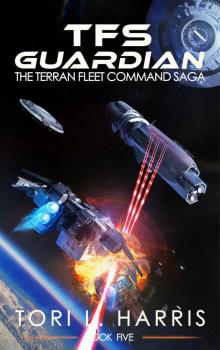 TFS Guardian: The Terran Fleet Command Saga – Book 5
TFS Guardian: The Terran Fleet Command Saga – Book 5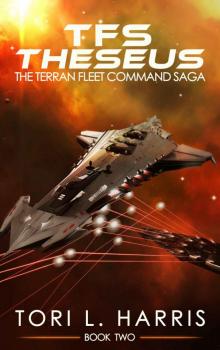 TFS Theseus: The Terran Fleet Command Saga – Book 2
TFS Theseus: The Terran Fleet Command Saga – Book 2